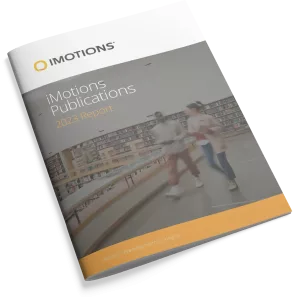-
The Effects of Ethnically Congruent Music on Eye Movements and Food Choice-A Cross-Cultural Comparison between Danish and Chinese Consumers
Musical fit refers to the congruence between music and attributes of a food or productin context, which can prime consumer behavior through semantic networks in memory. The vast majority of research on this topic dealing with musical fit in a cultural context has thus far been limited to monocultural groups in field studies, where uncontrolled […] -
Fielding hilarity: sensing the affective intensities of comedy education and performance
This article explores the affective dimensions of comedy education and performance through workshops with undergraduate acting students in Manchester, UK. Drawing on Suzanne Langer’s process philosophy and recent research in affect studies, the authors compose complex mappings of affective intensity as it circulates through stand-up comedic performances, using new empirical methods to combine ethnographic accounts […] -
Impact of mainstream classroom setting on attention of children with autism spectrum disorder: an eye-tracking study
It has long been reported that children with autism spectrum disorder (ASD) exhibit attention difficulties while learning. They tend to focus on irrelevant information and can easily be distracted. As a result, they are often confined to a one-to-one teaching environment, with fewer distractions and social interactions than would be present in a mainstream educational […] -
Factuality Checking in News Headlines with Eye Tracking
We study whether it is possible to infer if a news headline is true or false using only the movement of the human eyes when reading news headlines. Our study with 55 participants who are eye-tracked when reading 108 news headlines (72 true, 36 false) shows that false headlines receive statistically significantly less visual attention […] -
Can episodic future thinking affect food choices?
Episodic future thinking, defined as the ability to project oneself into the future, has proven useful to pre-experience the future consequences of present actions. We investigate how episodic future thinking influences the food choices of normal weight, overweight, and obese individuals. In doing so, we conduct a controlled laboratory experiment in which participants are presented […] -
Rational, emotional, and attentional models for recommender systems
This work analyses the decision‐making process underlying choice behaviour. First, neural and gaze activity were recorded experimentally from different subjects performing a choice task in a Web Interface. Second, choice models and ensembles were fitted using rational, emotional, and attentional features. The model’s predictions were evaluated in terms of their accuracy and rankings were made […] -
Dermal Fat Grafting to Reconstruct the Parotidectomy Defect Normalizes Facial Attention
Abstract Objectives/Hypothesis:Use validated eye‐tracking technology to objectively measure 1) the attentional distraction of facial contour defects after superficial and total parotidectomy and 2) changes in attentional distraction with abdominal dermal fat graft reconstruction. A Tobii Pro X3 eye-tracking camera system (120 Hz) and iMotions Biometric Research Platform software version 7.1.14670.18 were used to objectively measure how participants […] -
Rational, Emotional, and Attentional Choice Models for Recommender Systems
Abstract: This work analyzes the decision-making process underlying choice behavior. First, neural and gaze activity were recorded experimentally from different subjects performing a choice task in a Web Interface. Second, choice models were fitted using rational, emotional and attentional features. The model’s predictions were evaluated in terms of their accuracy and rankings were made for […] -
IMotions’ Automatic Facial Recognition and Text-Based Content Analysis of Basic Emotions and Empathy in the Application of the Interactive Neurocommunicative Technique LNCBT (Line and Numbered Concordant Basic Text)
This research paper focuses on the effectiveness of the Line Numbered Concordant Basic Text (LNCBT) of Narcotics Anonymous as an interactive neurocommunicative and gamificated technique to generate empathic emotions through its process and application. The LNCBT is studied as an effective educational, neurocommunicational and behavioral change technique for recovery from addictions. Firstly, it was analyzed […] -
The heterogeneous processes of cheating: Attention evidence from two eye tracking experiments
Dishonesty erodes society. Although much is known about dishonesty, the process leading up to the decision of whether to be honest or dishonest is often assumed to be homogenous and is not well understood. In this paper, we take a more nuanced approach and explore more closely the process of deciding whether to cheat or […]
Research Report 2024
In-depth look at the scientific landscape as powered by iMotions software, showcasing groundbreaking research and the impact of our tools in various scientific and industrial fields.

iMotions Science Resources
Looking for white papers, validation reports or research show casing iMotions Multimodal capabilities?
Share Your Research

850+ universities worldwide with an iMotions human behavior lab
73 of the top 100 highest ranked universities
710+ published research papers using iMotions
iMotions is used for some of the most interesting human behavior research studies carried out by top researchers around the world. Contact us to have your publication featured here.
The authors of these publications have used iMotions as a software tool within their research.
“Software should be cited on the same basis as any other research product such as a paper or a book; that is, authors should cite the appropriate set of software products just as they cite the appropriate set of papers” (Katz et al., 2020).
We therefore encourage you to cite the use of iMotions where appropriate.
How to cite iMotions
APA
iMotions (10), iMotions A/S, Copenhagen, Denmark, (2024).
Note: adjust the version and year where relevant.
5 Most Popular Blogs
Publications
Read publications made possible with iMotions
Blog
Get inspired and learn more from our expert content writers
Newsletter
A monthly close up of latest product and research news


